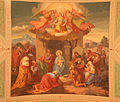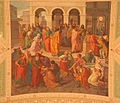frescos
The vaulted ceiling is graced by images of the Nativity and the Resurrection of Christ. Immediately above the altar, the Holy Trinity is depicted, surrounded by the Virgin Mary, the prophets of the Old Testament, the four evangelists, and the community of the faithful.
The choir to the left and right of the altar contains two frescoes: Christ is shown entering Jerusalem on Palm Sunday, and the Lazarus is shown resurrected. The artist managed to arrange a noteworthy interaction of natural light and his painting in the left side of the choir, depicting Jesus' entrance into Jerusalem on Palm Sunday. Around noon, rays of sunlight reach the Messiah and the disciples immediately surrounding him. In contrast, those waiting for him with their perfectly understandable, yet earthly wishes and needs—with sometimes desperate hope—are for the time being shrouded in shadow. Thus, power and certainty of the coming salvation are being contrasted with human weakness, doubt and despair.
- Frescos in the Zirl Parish Church
Above the Altar: Holy Trinity, Prophets, Evangelists and the Faithful
Left Choir: Jesus entering Jerusalem
Left Choir: Jesus entering Jerusalem, People waiting in anticipation
Right Choir: Resurrection of Lazarus
Vault Fresco: Nativity, Adoration of Magi and Shepherds
Vault Fresco: Resurrection of Christ
Vault Fresco:

Santa Maria Novella is a church in Florence, Italy, situated opposite, and lending its name to, the city's main railway station. Chronologically, it is the first great basilica in Florence, and is the city's principal Dominican church.
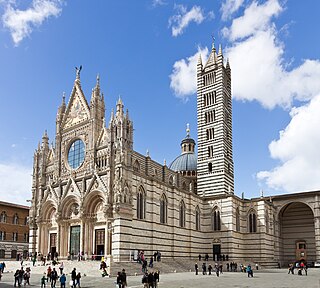
Siena Cathedral is a medieval church in Siena, Italy, dedicated from its earliest days as a Roman Catholic Marian church, and now dedicated to the Assumption of Mary.

The Sacred Heart Cathedral is a Catholic church in Sarajevo; commonly referred as the Sarajevo Cathedral, it is the largest cathedral in Bosnia and Herzegovina. It is the seat of the Archbishop of Vrhbosna, currently Tomo Vukšić, and center of Catholic worship in the city. The cathedral is located in the city's Old Town district.

The Collegiata di Santa Maria Assunta or Duomo di San Gimignano is a Roman Catholic collegiate church and minor basilica in San Gimignano, in Tuscany in central Italy. It contains important cycles of Renaissance frescoes by artists including Domenico Ghirlandaio, Benozzo Gozzoli, Taddeo di Bartolo, Lippo Memmi and Bartolo di Fredi. It falls within the UNESCO World Heritage Site of the "Historic Centre of San Gimignano", with its frescoes being described by UNESCO as "works of outstanding beauty".

The Basilica of Saint Francis of Assisi is the mother church of the Roman Catholic Order of Friars Minor Conventual in Assisi, a town in the Umbria region in central Italy, where Saint Francis was born and died. It is a papal minor basilica and one of the most important places of Christian pilgrimage in Italy. With its accompanying friary, Sacro Convento, the basilica is a distinctive landmark to those approaching Assisi. It has been a UNESCO World Heritage Site since 2000.

The Church of St. Trophime (Trophimus) is a Roman Catholic church and former cathedral located in the city of Arles, in the Bouches-du-Rhône Department of southern France. It was built between the 12th century and the 15th century, and is in the Romanesque architectural tradition. The sculptures over the church's portal, particularly the Last Judgement, and the columns in the adjacent cloister, are considered some of the finest examples of Romanesque sculpture.
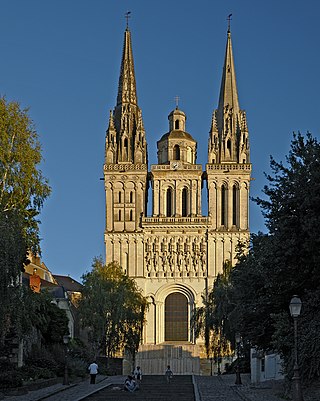
Angers Cathedral is a Catholic church dedicated to Saint Maurice in Angers, France. It is the seat of the Bishops of Angers.

The Basilica della Santissima Annunziata del Vastato is the Catholic cathedral of Genoa, northern Italy; its decoration employed the major baroque studios and artists in Genoa in the 17th century.

San Francesco della Vigna is a Roman Catholic church in the Sestiere of Castello in Venice, northern Italy.
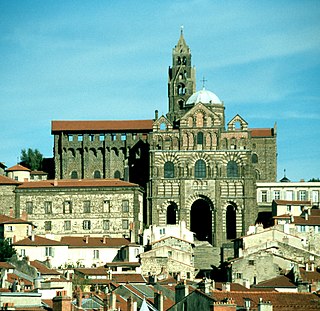
Le Puy Cathedral is a Roman Catholic church located in Le Puy-en-Velay, Auvergne, France. The cathedral is a national monument. It has been a centre of pilgrimage in its own right since before the time of Charlemagne, as well as being a stopover on the pilgrimage route to Santiago de Compostela. Since 1998 it has been part of a multi-location UNESCO World Heritage Site along France's Santiago pilgrimage routes. It is the seat of the Bishop of Le Puy.

The Hermitage of San Baudelio de Berlanga is an early 11th-century church at Caltojar in the province of Soria, Castile and León, Spain, 8 km south of Berlanga de Duero. It is an important example of Mozarabic architecture for its peculiarities, and was built in the 11th century, in what was then the frontier between Islamic and Christian lands. It is dedicated to Saint Baudilus or Baudel.

Keldby Church, famous for its frescoes, is located on the main road to Møns Klint in the village of Keldby, 4 km east of Stege on the Danish island of Møn.

The Church of Saint John of Jerusalem outside the walls is a Roman Catholic parish church in the city of Poznań in western Poland. The original church on this site was built at the end of the 11th century, making it one of the oldest churches within the present boundaries of Poznań.

St Martin's Cathedral is a cathedral in Slovakia. It is located in the town of Spišská Kapitula and is the cathedral church of the Spiš diocese.

Civita Castellana Cathedral is the cathedral of Civita Castellana, in central Italy. It is the episcopal seat of the Bishop of Civita Castellana.

Volterra Cathedral is a Roman Catholic cathedral in Volterra, Italy, dedicated to the Assumption of the Virgin Mary. It is the seat of the bishop of Volterra.
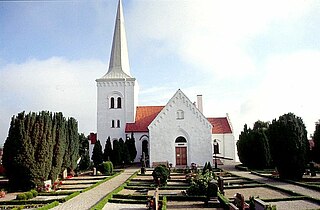
Anderslöv Church is a medieval Lutheran church built in the Romanesque style. Located in the village of Anderslöv, some 11 km (7 mi) southeast of Svedala in southern Sweden, it belongs to the Diocese of Lund. The church is noted for the medieval paintings which decorate its vaulted ceiling.
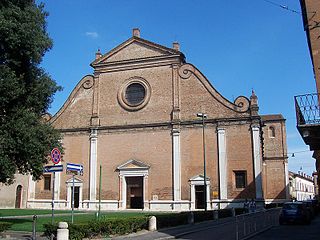
San Francesco is a late-Renaissance, Roman Catholic minor basilica church located on via Terranuova in Ferrara, Emilia-Romagna, Italy.

St. Nicholas Church is a Romanian Orthodox church located at 14 Romulus Cristoloveanu Street, Râșnov, Brașov County, Romania. It is dedicated to Saint Nicholas.
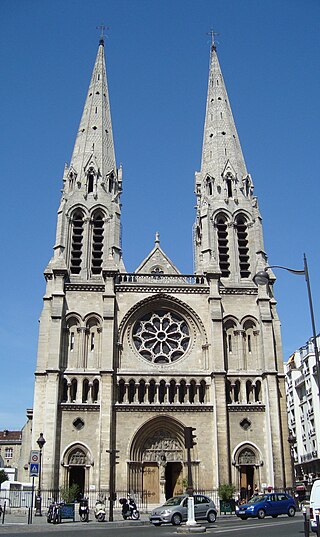
Saint-Jean-Baptiste de Belleville is one of the first churches of Neo-Gothic architecture built in Paris. Located at 139 rue de Belleville, in the 19th arrondissement of Paris, it was built between 1854 and 1859.





